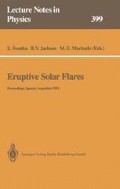Abstract
During the last few years, we have learned to distinguish the particle acceleration mechanisms involved in impulsive and gradual flares directly from particle observations at 1 AU. Energetic particles from impulsive flares are characterized as rich in electrons, 3He, and Fe and high ionization states of Fe indicate that the material has been heated in the flare. Particles from these events are only seen from magnetically well-connected flares, and the particles reach maximum intensity in a few hours. Particles from gradual events have heavy element abundances (e.g. Fe/C) and ionization states that are near their coronal values but protons are strongly enhanced. Gradual events come from a wide longitude region and particle intensities remain high for several days, much longer than the associated phenomena at the Sun. Most major proton events are gradual events, but some are impulsive or have both impulsive and gradual phases. The extended evolution of the major proton events in space and time can no longer be understood in terms of slow diffusive transport of particles through the corona and interplanetary medium, since particles from the impulsive events are found to behave much differently. The observations can be understood only if the major gradual events involve a large interplanetary shock wave that accelerates particles over an extended region of longitude for a long time.
Wave-particle interactions play a major role in the trapping and acceleration of particles in large events. Streaming particles may be scattered by self-amplified waves that provide a throttling mechanism that limits the particle intensities from large events and distributes particles in time as they leak from the source region. Diffusive containment allows particle acceleration to occur on open as well as closed field lines in both impulsive and gradual events.
Preview
Unable to display preview. Download preview PDF.
References
Cane,H.V., McGuire,R.E., and von Rosenvinge,T.T. 1986, ApJ, 301, 448.
Cane,H.V., Reames,D.V. and von Rosenvinge,T.T. 1988, J. Geophys. Res., 93, 9555.
Cane,H.V., Reames,D.V. and von Rosenvinge,T.T. 1991, ApJ, 373, 675.
Earl,J.A., 1987, Proc. 20th Internat. Cosmic Ray Conf. (Moscow), 3, 198.
Kahler,S.W., Sheeley,N.R.,Jr., Howard,R.A., Koomen,M.J., Michels,D.J., McGuire,R.E., von Rosenvinge,T.T., and Reames,D.V. 1984, J. Geophys. Res., 12, 209.
Kahler,S.W., Reames,D.V, and Sheeley,N.R.,Jr. 1990, Proc. 21st Internat. Cosmic Ray Conf. (Adelaide), 5,183.
Lee, M. A. 1983, J. Geophys Res., 88, 6109.
Lee,M.A., and Ryan,J.M. 1986, ApJ, 303, 829.
Luhn,A., Klecker,B., Hovestadt,D., and Möbius,E. 1987, ApJ, 317, 951.
Mason,G.M., Ng,C.K., Klecker,B., and Green,G. 1989, ApJ, 339, 529.
Mason,G.M., Reames,D.V. and Ng,C.K. 1991, Proc. 22st Int. Cosmic Ray Conf. (Dublin), to be published.
Murphy,R.J., Ramaty,R., Kozlovsky,B., and Reames, D.V. 1991, ApJ, 371, 793.
Ng,C.K. and Reames,D.V. 1991, Proc. 22st Int. Cosmic Ray Conf. (Dublin), SH 4.1.5, to be published.
Palmer,I.D. 1982, Rev. Geophys. Space Phys., 20, 335.
Reames,D.V. 1990a, ApJ Suppl. 73, 235.
Reames,D.V. 1990b, ApJ (Letters) 358, L63.
Reames,D.V., Cane, H.V., and von Rosenvinge,T.T. 1990, ApJ 357, 259.
Reames,D.V., Cane, H.V., von Rosenvinge,T.T. and Meyer,J.-P. 1991, Proc. 22stlnL Cosmic Ray Conf. (Dublin), SH 5.1.2, to be published.
Reames,D.V., Dennis,B.R., Stone,R.G., and Lin,R.P. 1988, ApJ 327, 998.
Reames,D.V., Kallenrode,M.-B., and Stone,R.G. 1991, ApJ, in press.
Reames,D.V. and Stone,R.G. 1986, ApJ, 308, 902.
Reames,D.V., von Rosenvinge,T.T. and Lin,R.P. 1985, ApJ, 292, 716.
Reid,G.C. 1964, J. Geophys. Res., 69, 2659.
Wibbewenz,G., Kecskemety,K., Kunow, H., Somogyi,A., Iwers,B., Logachev,Yu.I., and Stolpovskii,V.G. 1989, Solar Phys., 124, 353.
Van Hollebeke,M.A.I., McDonald,F.B., and Meyer,J.P. 1990, ApJ Suppl. 73, 285.
Author information
Authors and Affiliations
Editor information
Rights and permissions
Copyright information
© 1992 Springer-Verlag
About this paper
Cite this paper
Reames, D.V. (1992). Trapping and escape of the high energy particles responsible for major proton events. In: Švestka, Z., Jackson, B.V., Machado, M.E. (eds) Eruptive Solar Flares. Lecture Notes in Physics, vol 399. Springer, Berlin, Heidelberg. https://doi.org/10.1007/3-540-55246-4_96
Download citation
DOI: https://doi.org/10.1007/3-540-55246-4_96
Published:
Publisher Name: Springer, Berlin, Heidelberg
Print ISBN: 978-3-540-55246-8
Online ISBN: 978-3-540-46794-6
eBook Packages: Springer Book Archive

